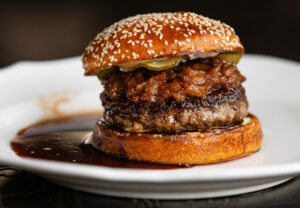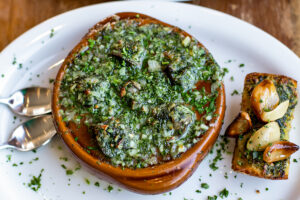Long before most of us wake up, a small army of unsung heroes scurries around wineries like ants, climbing ladders to do punch-downs, shoveling pomace out of tanks and prepping the crush pad for the arrival of new grapes, all while guzzling coffee and trying to stay awake.
Meet the warm body otherwise known as the Harvest Intern: That wide-eyed, gullible lackey enslaved by dreams of one day becoming a winemaker, supported by a measly $15 an hour and somehow still alive come November.
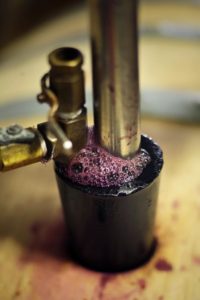
“I’d say ‘grunt’ is a good name for interns,” said Andrea Moore, a wine retailer who left her husband behind in Columbus, Ohio, for two months to work the 2013 harvest at Moshin Vineyards outside Healdsburg in the Russian River Valley.
“A marathon is the best way to describe it,” added Brad Schroeder, an aspiring winemaker who has interned in three harvests, at Harvest Moon Estate & Winery (Santa Rosa), Williams Selyem Winery (Healdsburg) and Grant Burge Wines (Australia). “It’s kind of like an uphill race and from there you just fall back down the hill.”
For Sebastian Zutant, a Washington, D.C., sommelier who came out on a lark to work the 2006 harvest at DeLoach Vineyards in Santa Rosa, “It was like going to boot camp. It’s definitely the most intense thing I’ve ever done in my life.”
While they may labor behind the scenes, interns play a huge role in each wine grape harvest. From late August to early November, hundreds of them flood into Sonoma to do the scut work so vital to producing quality wine.
In the hierarchy of winery fiefdoms, the intern falls far below full-time staff and even seasonal grape pickers on the pay scale. Many are fresh college graduates, but it’s not uncommon to find 30- and 40-somethings in between jobs and looking for adventure.
As the 2014 harvest ramps up to its peak, here’s a look at the self-imposed three-month sentence of hard labor, through the eyes of the intern.
EARLY WARNING SIGNS
Back in May, when wineries started posting jobs for harvest interns on UC Davis’ VENjobs website (wineserver.ucdavis.edu/careers/venjobs), telltale statements such as “No previous cellar and harvest work required” should have been ample warning. Other postings include, “Must be able to handle long hours, 5-7 days a week, be able to lift heavy loads and climb ladders.” Some, like Pott Wines in Napa Valley, tried to have a sense of humor about it. Its “Super Sexy Culty Pants Wine Internship” promised “extra groovy, mega luxurious swimming pools and movie stars.”
“For people who have never worked a harvest before, I try to warn them and gauge whether they’re gonna last,” said Katie Carter, assistant winemaker at DeLoach and a former intern who’s now in charge of hiring the intern crew every harvest. “The last thing I want is to hire someone and they leave after three weeks.”
INITIATIONS
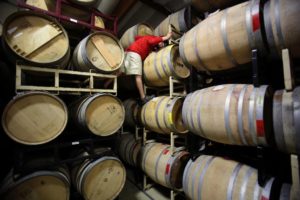
“There are usually one or two interns in the beginning who can’t stop asking, ‘When are the grapes gonna come in? I need my hours,’” said Shane Finley, winemaker at Lynmar Estate in Sebastopol, who interned at Copain in the Russian River Valley, Torbreck in the Barossa Valley in Australia and Domaine Pierre Gaillard in the Côte-Rotie of France. Now in charge of his own intern crews, Finley said, “I try to tell them, ‘Don’t worry, they’ll be here soon enough.’ And then they’re usually the ones who, when it starts getting crazy, say, ‘I need a day off. This is way too much.’”
Once the grapes start coming in, “There’s a first time where you put the boots on and dig out 6.5 tons of Pinot Noir [pomace] out of the tank, Moore explained. “When you do it the first time at Moshin, they take a photo of you to capture the moment.”
At DeLoach, Carter sees a familiar expression on interns at the beginning of every harvest. “Everybody’s got to dig out their first tank. You gotta suit up and get in the tank and everybody has this petrified and slightly excited look on their face.”
THE ROUTINE
When the intern is not cleaning and recleaning all the equipment, he or she is sorting grapes as they come in, something Zutant remembers as “a terrible experience — your hands rattle for like six hours afterward.”
Punch-downs require them to climb atop the fermentation tank, armed with a “a big, potato masher punch-down stick,” as Carter called it, and physically push down with all their body weight to break up and submerge the cap of seeds and skins that has risen to the top.
“You could do 20 punch-downs a day or 50 a day, it all depends on the winery,” noted Schroeder.
For Moore, “Sometimes trying to get through that cap was nearly impossible. I cried, literally I cried, it was that hard.”
Then there are the pump-overs, where the fermenting juice from the bottom of the tank is pumped back over the top cap to recirculate the mix. Later, after the juice is removed from the tank, a lucky intern gets to shovel several tons of pomace (seeds, skins and stems) out of the tank to make way for the next batch of grapes.
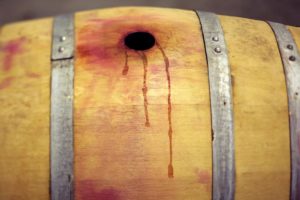
But it’s the cleaning that can really get monotonous — and hot.
“Cleaning the press was the most miserable process,” said Hardy Wallace, wine-blogger-turned-winemaker who made a splash in 2009 when he won the Murphy-Goode Winery international search for a “wine country lifestyle correspondent.” He now has his own Dirty and Rowdy Family Wines label, but to learn the ropes he interned at Failla Winery in Napa Valley in 2010 and Salinia Wine Company in the Russian River Valley in 2011.
“You have these tiny little brushes and you’re trying to get every little grape seed out of the press,” Wallace said. “You’re using hot water and you’re inside the press, which has been baking in the sun. It’s like a ‘Looney Tunes’ steam bath and you’re inside it. You more or less start talking in tongues.”
As the grind continues through 10- to 12-hour days, with only one day off a week, “Everybody gets a little zombie-like at some point,” Carter said. “The more tired people get, the more risk there is of falling into a vat or getting run over by a forklift or getting electrocuted. There’s a lot that can happen if you’re not watching out.”
UNFORGETTABLE MOMENTS
“I remember at Torbreck in Australia, working 21 hours straight and going through 45 tons of grapes,” Finley said. “The last four hours, from midnight to 4 in the morning, we were drinking instant coffee and shots of vodka just trying to get it done. We’re outside and it starts misting and we’re standing there in rain jackets. It’s pitch-black. We’re in the middle of the Barossa (Valley) and there are no lights and it just looks like a total wasteland. All we had was this standup light, like you get at Home Depot, and you’d drive off into the darkness in the forklift to get the grape bins. I thought I was going to fall asleep and run into something. At some point, your body just starts to shut down.”
And then there are the nights when interns think they might actually die. “I inhaled the pure gas of the ozone machine and I literally threw up,” Schroeder recalled. “You’re thinking, ‘I’m gonna die, I’m gonna die.’ And everybody’s laughing at you. I’ll never forget that one.”
THE WALKING WOUNDED
Harvest is probably best measured by the toll it takes on the body, day after day, week after six-day week, punch-down after punch-down. The most common injury is carpal tunnel syndrome from overworking the hands.
“I ended up with carpal tunnel issues that still plague me to this day,” Finley said. “It got so bad that in the middle of harvest I had to go to the doctor. I would wake up in the middle of the night and it felt like someone was stabbing my shoulder. My arms would be asleep until the middle of the afternoon.”
His Aussie mates told him to shrug it off. “Everybody’s John Wayne down there and I was trying to do it, too, but the pain hurt so much I was almost throwing up. It was that bad.”
The doctor gave him heavy anti-inflammatory medication and braces to wear while he slept.
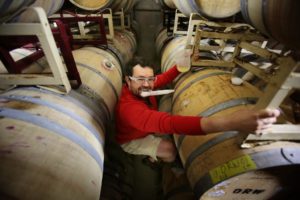
For Wallace, it got so bad that “In the middle of the night, both hands would fall completely asleep and you have no use of your fingers. I can remember having my alarm go off on my watch at 4 a.m. and my fingers on both hands are so numb I’m trying to turn it off with my chest because I have no use of my fingers.”
After Moore returned to Ohio, her fingers “were still swollen for months after I left the internship. I was really concerned about it. I couldn’t bend them the same. I wasn’t able to crack them, like actually make my knuckles crack, until February.”
Then there are the feet, which are constantly wet and sloshing through grape juice and water from hoses. Harvest veterans are loyal to waterproof boots, brands including Blundstone, Redback and Rossi. But there’s always the naïve intern who shows up in tennis shoes.
“I used to call it jungle foot,” Wallace said. “It’s like what happens when you hike for weeks in a wet climate. Everything starts falling off your feet — the skin and everything.”
While interning at Mulderbosch Vineyards in South Africa, Carter got a nasty case of athlete’s foot after wearing soggy hiking boots day after day. “I went to the pharmacy, but they’d never heard of ‘athlete’s foot.’ They had no idea what I was talking about. It was super embarrassing.”
THE HARVEST WEIGHT-LOSS DIET
“The girls love it because they end up losing like 15 pounds — everyone does,” Schroeder said. “I was easily eating like 3,000 calories a day, and I ended up losing like 7 pounds by the end of harvest.”
Wallace lost 18 pounds during the harvest of 2011. “A lot of that was from barrel rolling,” he said. You’re physically rolling 500-pound barrels for like four hours a day. I was exhausted, but in the best shape I’ve ever been in my life.”
Zutant lost around 15 pounds in 2006, which he attributes to “hauling hoses up ladders and doing punch-downs at 4 a.m. It was pretty brutal, but I was pretty ripped by the end of it.”
THE NICKNAMES
“When I was at Williams Selyem, the assistant winemaker came up to me on the first day and said, ‘You look like a Gary,’” Schroeder remembers. “I told him, ‘My name’s Brad,’ but that was it, my name was Gary for the rest of harvest. By the end, at least half of the people didn’t know my name was Brad.”
At Lynmar, Finley nicknamed an intern “One Speed” because “he never seemed to be able to go fast or slow, just one speed all the time.”
Said DeLoach’s Carter, “I found out halfway through one harvest they were all calling this one dude ‘Snake’ and another guy was ‘Biscuit.’ You never really find out why.”
GOING AWOL
“I’ve never seen it, but you always hear the stories of people just walking off the job and never coming back,” Wallace said. “That’s one of the cardinal sins in the wine business. Once harvest starts, you don’t quit until it’s over.”
But “every once in a while, you get someone who cracks,” Finley said.
In 2006, he had an intern who was an avid bow hunter and had been camping near a winery in Kenwood where grapes were being processed one day.
When the winery owner mentioned he was having a problem with deer on his property, “this guy just kind of lost it, and he took his bow and arrow into the woods to go after the deer,” Finley said. “He just needed a couple of days off, and then he came back.”

THE END IS NEAR
By the time the leaves start changing colors and the grapes are all picked in late October and early November, there’s nothing left to process and nothing left to clean. It’s time for the ceremonial dumping of the uniform.
“Pretty much all the clothes I took out there to work in, I threw away after it was over,” Moore said.
Then there’s usually a harvest party to celebrate. At DeLoach, after more than a thousand tons of grapes have been handled, a big party is thrown that involves a pool and barrel races.
“Afterward, you have this bond that you made it through something together,” Wallace said. “You’re like family.”
“One of the most gratifying things is at the end of the year to see how everybody’s come together,” added Lynmar’s Finley. “I hate to use the word fraternity, but it’s almost like you’re playing together on a sports team. You create that bond for life.”


